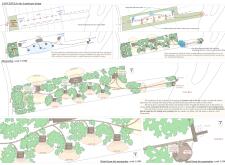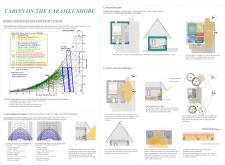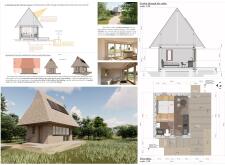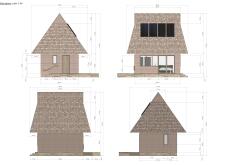5 key facts about this project
The architectural design focuses on creating a seamless integration between indoor and outdoor spaces. Each cabin is situated strategically to maximize views while maintaining privacy. The choice of materials, which includes natural wood and reinforced concrete, supports thermal performance and enhances durability. Large windows establish a visual connection with the surrounding landscape, allowing natural light to permeate the living areas and promoting energy efficiency.
The project’s layout incorporates walkways and communal spaces, fostering a sense of community among residents. The careful arrangement of cabins ensures minimal impact on the existing flora while enhancing user experience through thoughtful landscaping.
Unique Environmental Strategies
This project employs several innovative design approaches that contribute to its sustainability and contextual relevance. The cabins utilize passive solar design techniques, including strategically placed overhangs and window orientations, to manage solar gain effectively. This reduces reliance on mechanical heating and cooling systems, aligning with environmental conservation goals.
Additionally, the use of local materials not only supports the regional economy but also helps the structures blend naturally into the landscape, reducing visual disruption. The architecture maintains a human scale, ensuring that the cabins are approachable and comfortable for visitors. This focus on user experience sets the project apart from typical vacation rentals that often prioritize aesthetics over functionality.
Architectural Details and Specific Design Features
Attention to detail is evident in the cabin design, with features such as a pyramidal roof that echoes traditional Latvian forms while offering modern functionality. The floor plans are optimized for efficient use of space, featuring compact layouts that still accommodate the essential needs of residents. These designs maintain a balance between openness and privacy, allowing for intimate spaces without sacrificing connectivity to the outdoors.
The overall project encourages exploration and interaction with the surrounding environment. Pathways are designed to guide visitors through the landscape, promoting a sense of discovery. Communal areas, including a shared boat deck and a central fireplace, serve as focal points for social interaction, enhancing the communal living experience.
For a more in-depth understanding of this project’s architectural plans, sections, designs, and innovative ideas, consider reviewing the project presentation for additional details. Explore how these elements come together to create a cohesive architectural experience focused on sustainability and community engagement.


























